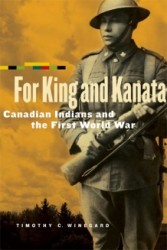Article Origin
Volume
Issue
Year
For King and Kanata:
Canadian Indians and the First World War
By Timothy C. Winegard
Published By University of Manitoba Press
Pages: 224
Reviewed by Christine Smith
In “King and Kanata: Canadian Indians and the First World War” author Timothy C. Winegard takes a comprehensive look at the history of First Nations people and their experience on the battlefield and home front during this time of war.
Winegard writes about the Indian and Settler-State experience and states early on that “warfare played an important role in the political, social, cultural and genetic frameworks of Indian nations,” and “in pre-contact warfare, raiding parties which were led by proven war chiefs and usually numbered less than 200 warriors, were sent to settle scores, to acquire provisions, or to avenge the deaths of or replace deceased clan members (known as mourning wars).”
But despite earlier warfare experience and the First Nations’ pledge to the Crown that their men would fight to honour their long-standing military alliances with the Europeans during times of war, the Canadian government was of the opinion that “status Indians were unsuited to modern, civilized warfare.”
Under the British North America Act and the Indian Act, Canadian Indians did not have the rights and responsibilities of citizenship, and the government of Canada did not expect or need Canadian Indians to take up arms in what they saw as a foreign war.
Another apprehension the Canadian government had was that including Indians in “an expeditionary force could violate treaties, as evidenced by the position of the government during the Boer War.”
Canada’s stance on First Nations soldiers’ involvement in the First World War changed when Britain intervened in 1915. Britain demanded Canada to actively recruit First Nations soldiers to meet the increasing need for more manpower on the battlefields. The number of First Nations soldiers that participated has never fully been disclosed. This is due to the fact that “there were undoubtedly cases of Indian enlistment which were not reported to the department,” and most “status Indians were not recorded as such upon enlistment, as attestation papers did not record race.”
After Britain intervened and demanded that First Nations become a part of the First World War, complications arose between the national and international forces that influenced the more than 4,000 status Indians who served in the First World War. Winegard reports that subsequent administrative policies affected First Nations soldiers at home, the battlefield and as returning veterans.
For history buffs, this book is a must read for the account of just how much Canadian First Nations participated in the First World War, why they participated and what happened to them after the war.
- 3000 views

